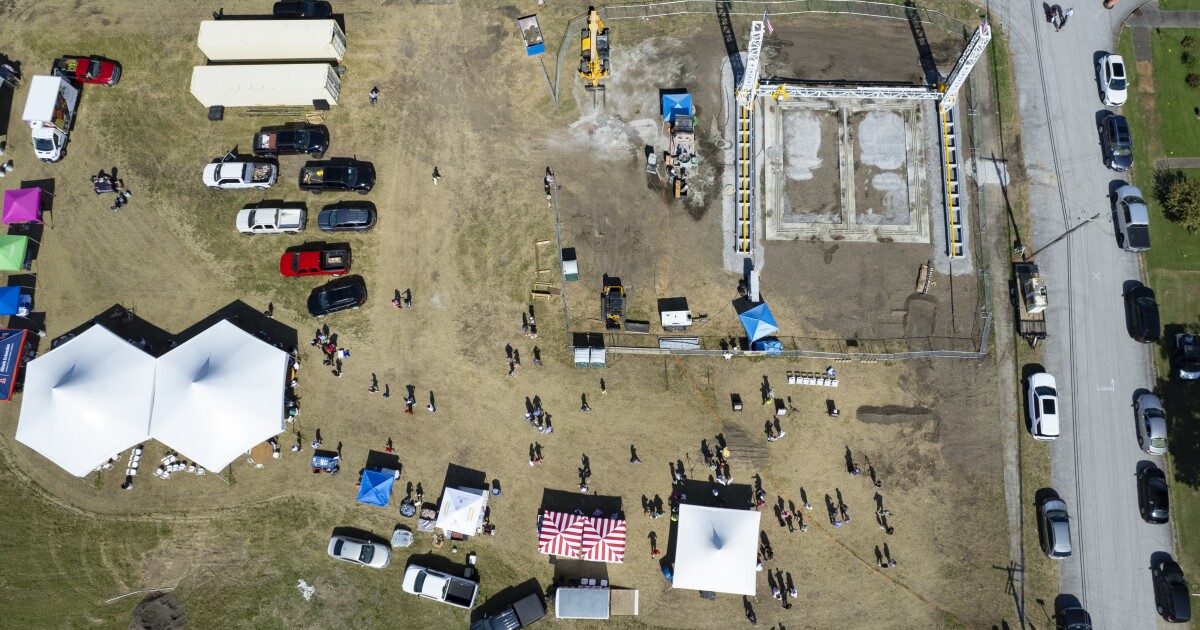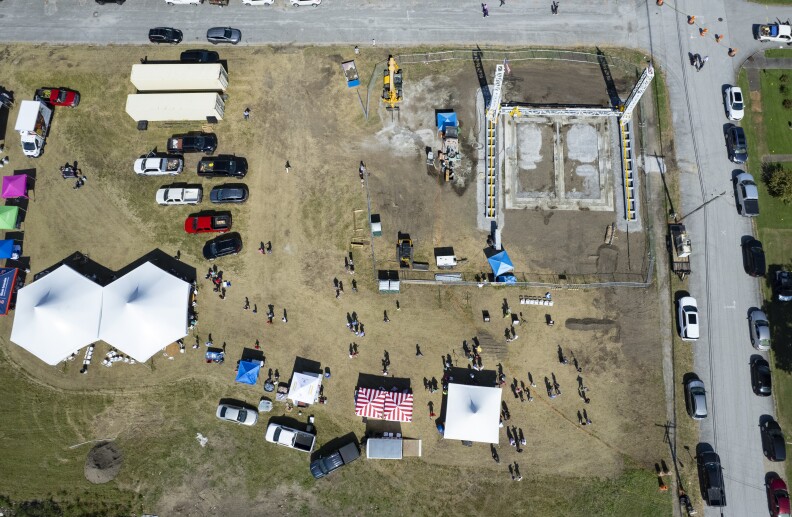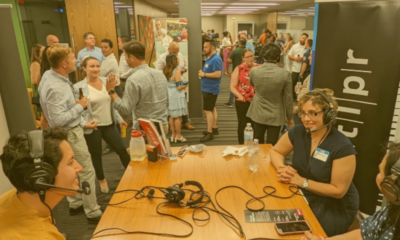Business
Cairo to make affordable housing with 3D printer

[ad_1]

A massive 12-ton 3D printer has arrived in Cairo to construct a duplex on vacant land behind the town’s city hall. The towering gantry system stretches into the sky as the machine, guided by a computer rendering, layers a specialty concrete mix like toothpaste squeezed from a tube.Hundreds gathered in Illinois’ southernmost city on Saturday to witness a demonstration of the futuristic printer, with American flags waving from the top of its two tall legs. 3D printing is emerging as a promising technology that could accelerate affordable housing development nationwide. The machine, the first of its kind in the region, is owned by Eminence Resource Inc., based in Harrisburg, 80 miles north of Cairo. The company is donating the duplex to the city.
Officials toss ceremonial dirt on Saturday in Cairo as crews prepare to oversee construction of a 3D-printed duplex.
Residents cheer the start of construction of a new 3D-printed duplex in Cairo on Saturday, which will be donated to the city and house two displaced families.
For this town of roughly 1,600 people, the 3D-printed duplex represents a hard-fought victory for affordable housing, years in the making. This is Cairo’s first new home construction in nearly 50 years.The town has been grappling with how to replace some of the affordable housing lost when the federal government demolished two family public housing complexes, Elmwood and McBride, in 2019. Nearly 400 residents were displaced. A few years earlier, the U.S. Department of Housing and Urban Development had taken the rare step of seizing control of the Alexander County Housing Authority from local officials, citing severe mismanagement and unsafe living conditions.
Harrisburg-based Eminence Resource Inc.’s 3D printer is expected to construct the interior and exterior walls of the duplex in just 45 hours.
HUD officials argued that the buildings were too dilapidated to repair. Although displaced residents were given rental vouchers to help subsidize their rent in the private market, many had to move more than 30 miles away due to a lack of affordable housing in Cairo.“What’s really cool about this is the first two families who get to move into this amazing duplex are going to be some of the first families who were displaced from the housing crisis of the Elmwood and McBride demolition,” said State Sen. Dale Fowler, R-Harrisburg, whose district covers the region, and who helped connect Eminence managers and Cairo city officials.“We’ve got people – they’re ready to come home, and I don’t blame them,” added Cairo Mayor Thomas Simpson, to cheers from the crowd. The city is taking applications from former Elmwood and McBride residents for the homes but hasn’t said yet who will move into them.
Cairo Mayor Thomas Simpson speaks to a crowd of several hundred people on Saturday, marking the start of construction on a 3D-printed duplex.
When Cairo tried to replace some of the affordable housing the town had lost, it encountered the same challenges that many rural towns and distressed urban areas face. Many rural towns still operate public housing apartment complexes, but when they fall into disrepair, there’s few options to replace them.In the 1970s, the federal government shifted its affordable housing strategy, moving away from direct funding for public housing construction toward public-private partnerships. This approach included providing vouchers to pay a portion of tenants’ rent in the private market, but that is not much help to communities with a shortage of private-market rentals.When new affordable housing apartment complexes are constructed, they are typically built by private developers and nonprofits using complex tax-credit deals that are also difficult to make work in smaller communities where projects often can’t reach the scale or rental price point needed to be profitable.In Cairo, housing for children and their parents is a critical need. State data shows that more than one in five children in Cairo’s pre-K district are considered homeless, under a broad definition that includes kids who are unhoused, doubled up with friends or relatives, couch-surfing, or living in hotels and other temporary accommodations.
Officials from Harrisburg-based Eminence Resource Inc. say they hope to use the company’s new 3D printer to build affordable housing across southern Illinois.
Though the addition of two new housing units does not solve the breadth of the city’s housing crisis, Simpson said city officials are working on plans to fund the development of additional housing on the same lot.“Folks, this is just the beginning,” he told the crowd Saturday.It is expected to take the 3D printer about 45 hours to construct the duplex’s interior and exterior walls, with crews working through the night over the next two weeks to complete the job. Several more weeks will be needed for finishing work, including hanging drywall, installing plumbing, electricity, flooring, and other interior elements like kitchen and bathroom fixtures, to make the home move-in ready.
This 3D printer from Black Buffalo 3D, weighing over 12 tons, arrived on three semitrailers from a New Jersey warehouse.
3D printers could accelerate the development of affordable housing, reducing construction time from months to just weeks compared to traditional construction methods.
Eminence purchased the printer from Black Buffalo 3D and it was delivered from a warehouse in New Jersey in parts by three semitrailers to Cairo. This project is the inaugural use of the machine at its new southern Illinois location, though Josh Burtis, the general manager of Eminence, said it will soon go to work building homes across southern Illinois. Burtis said his company purchased the printer in response to the growing need for affordable housing in the region. While it can take months to build a home using traditional construction methods, 3D printers can do it in a matter of weeks.“Our goal by bringing this technology here is showcasing that, hey, we’re here to work. We want to build houses, more resilient homes, fast as we can put them up and put people back in housing here,” Burtis said. “Because the more housing we get, the more people we get here – that keeps building these communities back, and that’s our main goal, to build affordable workforce housing and just keep growing these communities back.”Capitol News Illinois is a nonprofit, nonpartisan news service covering state government. It is distributed to hundreds of newspapers, radio and TV stations statewide. It is funded primarily by the Illinois Press Foundation and the Robert R. McCormick Foundation, along with major contributions from the Illinois Broadcasters Foundation and Southern Illinois Editorial Association.
[ad_2]
Source link
Business
Laclede’s Landing is moving from nightlife hub to neighborhood

[ad_1]

Laclede’s Landing has cycled through many identities throughout the history of St. Louis. Now, some people involved with its redevelopment in recent years hope the landing’s next one will be as a residential neighborhood.The small district tucked directly north of the Gateway Arch National Park has quietly undergone a massive redevelopment with more than $75 million pouring into the rehabilitation of many of the historic buildings at the landing.“We are starting to feel that momentum, especially in the last really 60 days. Things have drastically changed around here,” said Ryan Koppy, broker and owner of Trading Post Properties and the director of commercial property for Advantes Group.Advantes alone shouldered the rehabilitation of six of the historic buildings, which now sport a mix of apartments and retail or office space, he said. Four of those buildings are completed, and of the 119 apartments available, about 90% are filled, Koppy said.“It just shows you what kind of demand we do have for the area,” he said. “We’re separated from downtown a little bit, and for the tenants, their local park where they’re walking their dogs, it’s a national park.”
Sophie Proe
/
St. Louis Public RadioInterior of the Peper Lofts at Laclede’s Landing on Aug. 16
Another 40 apartments are set to come online next year along with some retail space, Koppy said. He added he’s noticed a wide range of people who are considering and moving into the newly refinished apartments.“It’s very mixed, surprisingly,” Koppy said. “We have a lot of young professionals, maybe on their second job out of [university], we have some empty nesters too.”Part of the newfound momentum comes from a new market, the Cobblestone, and coffee shop, Brew Tulum, opening recently and bringing more foot traffic to the area, said Brandyn Jones, executive director of the Laclede Landing Neighborhood Association. She added that more apartments are set to come online within the next few months.“We have a great riverfront area here and so there are plans in the works to activate those spaces, bring people in,” she said.That could be more daytime events, like a farmers market, music festivals (one of which is happening this weekend) or just bringing in food trucks to Katherine Ward Burg Garden, Jones said. It’s a departure from the identity the district held a few decades ago as a hub for nightlife and entertainment.“That’s part of what connects so many people to Laclede’s Landing,” Jones said. “It’s important to tell the story of where we’re evolving. It won’t be what it was in the same exact way, but it will still be fun, and it can be fun early morning, midday or late night.”It’s a view shared by Koppy.“It’s grown up, it’s a bit mature,” he said. “We’re not going to have 3 a.m. bars here anymore because we have residents here.”Koppy added that Advantes is joined by other developers working to rehabilitate buildings in the district.“We all work in unison,” he said. “If I get a call and [a client is] asking for something and maybe the square foot doesn’t really match up with what I have available, but I know it matches up over there, they’re getting a very warm welcome and introduction.”
Sophie Proe
/
St. Louis Public RadioRyan Koppy looks out the window of Brew Tulum Specialty Coffee Experience on Aug. 16 at the Cobblestone on Laclede’s Landing in downtown St. Louis.
This push toward making Laclede’s Landing a residential neighborhood also comes alongside broader conversations about the future of downtown St. Louis more generally as it looks to move away from a dependence on office space. While the city as a whole continues to lose population, downtown added about 1,700 people between 2010 and 2020, according to U.S. Census data.“It’s been wonderful timing to have all that going on, that stress that you’re not just in downtown to work has been critical to part of this rejuvenation and energy down here,” Jones said. “Sometimes people forget Laclede’s Landing is part of downtown, really the original downtown.”And success in the small district could spread beyond its small confines and potentially serve as a model for success, Koppy added.“My idea is, if we could get all the great things of St. Louis coming in through here, we can eventually spread that,” he said. “We understand we can’t change the whole world, but we’ll just make the effort to try and change the world around us.”
[ad_2]
Source link
Business
St. Louis barbecue festival Q in the Lou canceled

[ad_1]

The largest barbecue competition and tasting festival in St. Louis, Q in the Lou, has been canceled. The event was planned for Sept. 6-8, but organizers decided to cancel it due to poor ticket sales and insufficient corporate sponsorship.The traveling festival had low attendance in Denver last week, said Sean Hadley, a festival organizer.“We made the tough decision to cancel Q in the Lou,” said Hadley. “We’re seeing a lack of support … it’s just not there.”The traveling event first came to St. Louis in 2015 and drew hundreds of people to downtown St. Louis for barbecue, live music and a “major party.”“It shut down out of the blue … I’ve gone every year,” said Scott Thomas, local chef and food blogger. “It’s brilliant. You could take a tour of some really amazing barbecue restaurants and competition barbecue guys all in one place.”In a late July news conference, city officials touted Q in the Lou as a significant tourism draw and a boost for downtown revitalization.“Bringing a signature national festival back to downtown St. Louis … is making us stronger,” Greater St. Louis Inc. CEO Jason Hall said then.Less than a month later, ticket holders from every festival stop learned they’d be refunded. On Monday, organizers privatized the Q in the Lou website and deleted its social media accounts.Conner Kerrigan, a spokesperson for Mayor Tishaura Jones’ office, said city officials are disappointed the festival won’t be back this year.“St. Louis knows how to throw a festival … bringing people together to celebrate our culture is one of the things we do best as a city,” Kerrigan said in a statement. “Should Q in the Lou try to come back next year or any year after that, they’ll have the support of the Mayor Jones administration.”
[ad_2]
Source link
Business
Alton’s Jacoby Arts Center likely to relocate permanently

[ad_1]

The Jacoby Arts Center, a staple of Alton for many in the Metro East community, will likely permanently move out of its downtown building at the end of September.Its departure and relocation from the historic building that the arts center has called home for the past 20 years has created a tense situation for not only the arts center’s supporters but also the local development company working to revitalize Alton’s downtown that owns the building.“It’s an unfortunate situation,” said Chad Brigham, the chief legal and administrative officer with AltonWorks, the real estate company owned by another prominent local attorney working to develop the town. “I wish there wasn’t misunderstanding and disappointment in the community. It’s difficult sometimes to clarify that.”When news of the likely departure spread in June via a letter from the Jacoby Arts Center to its supporters, an outcry on social media quickly followed. Some assumed it would be the end of the arts center.“There’s a lot of feelings right now that I think are more about the building itself than there are about the Jacoby Arts Center,” said Valerie Hoven, vice president and treasurer of the nonprofit arts center’s board.For supporters of the Jacoby, moving from the building and likely never returning will be a sad affair. Exactly what’s next for the arts center remains unclear. However, Jacoby board members believe this will not be the end of the organization. It will likely look different though.
Sophie Proe
/
St. Louis Public RadioThe Jacoby Arts Center earlier this month in downtown Alton
Sophie Proe
/
St. Louis Public RadioThe Alton-based Jacoby Arts Center features more than 75 St. Louis-area artists and their work.
The history of the buildingFirst dubbed the Madison County Arts Council, the nonprofit arts center renamed itself after the Jacoby family gave it the current building in 2004. AltonWorks founder John Simmons purchased the Jacoby Building in September 2018, according to property records from the county.Managing the large building, at 627 E. Broadway, became too expensive for the Jacoby Arts Center. In 2018, the organization approached Simmons to purchase it, said Dennis Scarborough, a past president of the board and a downtown business owner.“Of course, it sounded really, really good,” Scarborough said of Simmons’ purchase. “He took over the insurance, property taxes, all those kinds of things that were really, really getting into our budget, and he rented it to us at a fair price.”The two parties entered into a lease agreement initially for five years. Since then, Simmons has spent more than $1 million in upkeep, taxes, insurance and more on the building. The lease has been extended twice until the end of September this year.Over the six years, Jacoby paid $1,500 per month, which covered a portion of the utilities.“It’s been wonderfully generous of AltonWorks,” Hoven said.Because the building is aging and needs repairs, Brigham with AltonWorks and those connected to the arts center have long known the Jacoby Arts Center would need to relocate — at least temporarily.
Renovations on the Jacoby building will begin this fall. They’ll include modernizing the aging building, repairing the old elevator and putting in apartments on the second and third floors.
News of the likely departure and controversyRenovations will begin this fall. They’ll include modernizing the aging building, repairing the old elevator and putting in apartments on the second and third floors.In May, it became clear that a preliminary proposal for the arts center to return to the building after renovations finished in 2026 would not work for them, Hoven said.She estimates the first floor and basement of the Jacoby Arts Building span roughly 20,000 square feet.
Chad Brigham is a business and legal adviser for AltonWorks.
AltonWorks’ initial idea floated to the arts center would only provide 2,553 square feet, according to both Hoven and Brigham. While the board calculated the price for the new space to be at least triple the current payment, Brigham said there was never a specific price discussed.“No discussion in terms of actual rent price,” he said.AltonWorks didn’t make a specific rent offer because the organization doesn’t even know itself, Brigham said.In addition to cash from John Simmons, there will be loans, tax increment financing and state tax credits to cover the $20 million in building renovations. The entities financing the cost of renovations will also help determine the rent when the construction is complete, Brigham said.Regardless, the price required to return will be too much for the arts center to pay, Hoven said. Also, the organization would like to maintain the many programs it offers to the community — a rentable event space, a dark room and a clay studio, for example — in the future.“For us to really meet the needs of the community and be sustainable, we need a space where we can offer some of those programs — the artists’ shop, and other spaces that offer some kind of income as well — so that we can continue to give money back to the community,” she said.AltonWorks offered at least two other locations as possible alternatives from their vast stock of buildings along Broadway to house the arts center during the roughly 18 months of construction. Those alternatives came with similar deals requiring the Jacoby to cover only utilities, Brigham said.“We did put in a great deal of work behind the scenes in trying to find an interim solution,” Brigham said. “We wanted to find a place for them to go, where it was easy for them to continue programming, whether it’s 100% of it or some portion of it, that would work for them.”Initially, the arts center hoped to keep the basement during the renovations, Hoven said. When it became clear the preliminary offer to return was for much less space than the arts center anticipated, the letter to the community was sent.“The letter that came out was merely showing our surprise,” Hoven said. “Don’t misinterpret it as panic. Don’t misinterpret it as desperation.”
Sophie Proe
/
St. Louis Public RadioA smorgasbord of radios are displayed at the Jacoby Arts Center in Alton.
The commentary on social media was passionate. Some critics of AltonWorks said the organization has good intentions but hasn’t executed those plans. Others said Jacoby hasn’t planned well enough for the future.For Brigham and the AltonWorks team, some of the criticism has been disappointing.“I thought that there were some decent solutions. Were they perfect? No, but they were very, I thought, very good solutions,” he said. “And the fact that it has come to the point that it is right now is a bit hurtful.”AltonWorks remains committed to the arts, Brigham said. John Simmons remains one the largest donors of the Jacoby Arts Center, Hoven and Brigham said.“I don’t think there’s ever been a question of our support of that organization — of our affinity for that organization,” Brigham said. “While some of the events were unfortunate, some of them were encouraging. The entire community rallied around the Jacoby Arts Center. That’s a good thing. It’s a good thing to have a love for the arts like that in a downtown community.”Sara McGibany, the executive director of Alton Main Street, an organization aimed at preserving the town, said AltonWorks should be commended for its vision. In many ways, her organization and AltonWorks share a vision for a thriving downtown.Even though AltonWorks hosts public meetings, McGibany believes the current situation lacks true community engagement.“We really think that if AltonWorks can get past some of the communication hurdles — and harness the community’s passion and shift to more of a bottom-up decision-making process that centers on community input — then we can turn around the growing sentiment of distrust that’s happening now,” McGibany said.Scarborough, the past board president and downtown business owner, echoed the praise for Simmons and his support of the Jacoby Arts Center. With the Jacoby likely moving, the future looks bleak, though.“It’s a community arts center that does a lot of good work,” Scarborough said. “The community is going to suffer, and they’re going to be missed by the community if they’re not there.”
Eric Lee
/
St. Louis Public RadioShalanda Young, director of the federal Office of Management and Budget, talks to Illinois U.S. Rep. Nikki Budzinski, D-Springfield, during a tour of a construction project by AltonWorks last April in Alton. AltonWorks, who is building the LoveJoy Apartment Complex is receiving over $1 million in federal funding.
What does the future hold?AltonWorks will continue forging ahead with its ambitious plans to revitalize Alton. The organization hopes to conclude construction on the Wedge Innovation Center, which will have a restaurant, retail and co-working space, this fall. Lucas Row, a mix of apartments and retail space, is scheduled to be completed next spring.The remainder of the arts and innovation district, currently named after the Jacoby, will also move forward.“I believe in two years it’s going to be a much different place,” Brigham said of Alton. “It’s going to be thriving. It’s going to be new businesses, new tenants — and it’s going to be a nice proof of concept for what you can do in a small community like that.”The Jacoby board recently formed a strategic planning committee. Its task: figuring out what’s next for the arts center. The committee will reevaluate what space the Jacoby needs, what programs it wants to offer to the community and how they want to make that a reality.Keeping the arts center is essential for board members like Hoven. In her experience, it’s been a place where local aspiring artists get their start.“Art is one of the only ways to show your true authentic self,” Hoven said. “And there’s more people than I realized who do not get that opportunity every day.”The Jacoby will shut its doors to pack over the next month. Hoven said she’s optimistic the board will have concrete plans by the end of September when their lease officially ends.“Alton is such a fabulous and supportive community,” she said. “We still have lots of great options, so that the Jacoby Arts Center will continue to thrive in Alton and beyond.”
[ad_2]
Source link
-

 Politics2 years ago
Politics2 years agoPrenzler ‘reconsidered’ campaign donors, accepts vendor funds
-
Board Bills1 year ago
2024-2025 Board Bill 80 — Prohibiting Street Takeovers
-

 Board Bills3 years ago
Board Bills3 years ago2022-2023 Board Bill 168 — City’s Capital Fund
-

 Business3 years ago
Business3 years agoFields Foods to open new grocery in Pagedale in March
-

 Business3 years ago
Business3 years agoWe Live Here Auténtico! | The Hispanic Chamber | Community and Connection Central
-

 Entertainment2 years ago
Entertainment2 years agoOK, That New Cardinals/Nelly City Connect Collab Is Kind of Great
-

 Entertainment3 years ago
Entertainment3 years agoSt.Louis Man Sounds Just Like Whitley Hewsten, Plans on Performing At The Shayfitz Arena.
-

 Local News2 years ago
Local News2 years agoFox 2 Reporter Tim Ezell Reveals He Has Parkinson’s Disease | St. Louis Metro News | St. Louis





